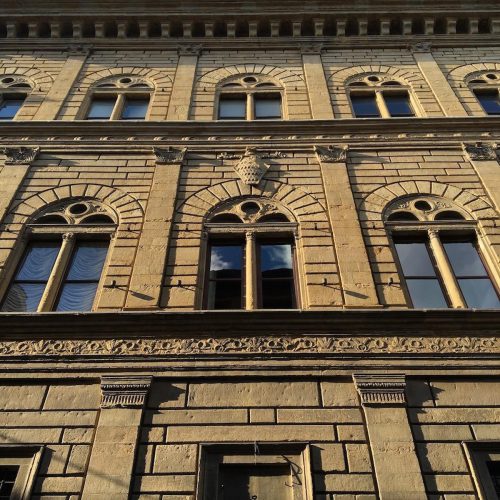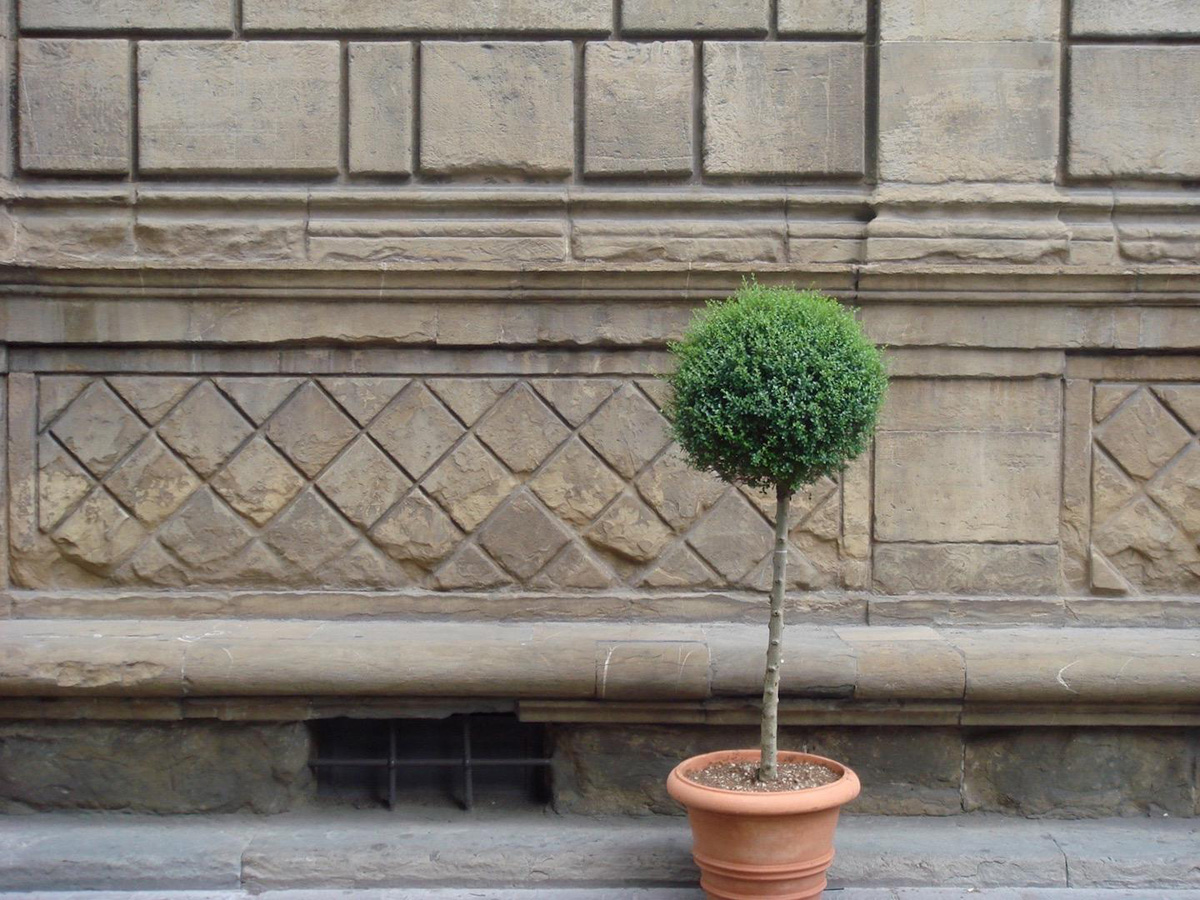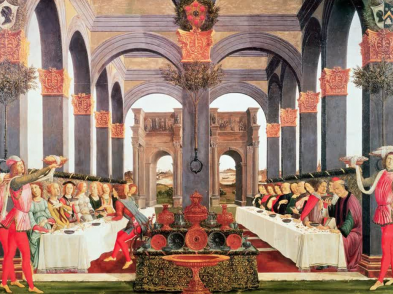You could say there was something of an age difference. I was 18 years old; the house was 536. Nevertheless, it was love at first sight. Sitting in a darkened college classroom in the American South, hazily absorbing the steady stream of Renaissance masterpieces that flickered before me, my eyes suddenly widened. The professor’s monologue on classical pilasters and arched windows quickly faded as I fixated on glowing skin, chiseled features and an elegant stature. Rucellai was the name—Palazzo Rucellai—a private residence in via della Vigna Nuova. I duly took note and, changing my major from biology to art history as a result of this chance encounter, wore my heart on my sleeve from that day forward.

The golden glow of Palazzo Rucellai
Ours was a long-distance relationship, at first. Graduate study and then a teaching career guaranteed frequent visits to Florence. On every pilgrimage, I never failed to pay my respects, to stand in the far corner of the tiny piazza opposite the palace, to admire at a remove. Palazzo Rucellai was still in family hands, after all. Closed to the masses. Until, that is, the perfect storm of a 12-month sabbatical and a vacant room with a pristine address landed me inside the palazzo of my dreams. That I now possessed a key to the front door of this magnum opus exhilarated me.
Life together was something of a roller coaster. The house was often indulgent, coaxing me into the courtyard on silent nights, enticing me to run my hands over its girdled columns. Other times, it was decidedly uncharitable, trapping me in its birdcage elevator or releasing odors and noises befitting of its age.
The cracking joints and chronic gas were par for the course, I reasoned, but the cold shoulder? Despite its fickle ways, Palazzo Rucellai provided me with more than a sabbatical address—it gave me a stage on which to perform or, depending upon my mood, a screen behind which to hide. I, in turn, became fiercely protective of the house, defending it against neighborhood gossip, even as, behind doors, I worked tirelessly to unearth its innermost secrets. Admittedly, we’ve had our ups and downs; yet more than 30 years on, now living apart, Palazzo Rucellai and I remain soulmates.

The built-in bench of the façade on via della Vigna Nuova
Why do we fall in love with houses? Leon Battista Alberti, the 15th-century architect of Palazzo Rucellai, understood well the lure of architecture—a pull so strong, in certain instances, that mind has no sway over matter, that we cannot but propel ourselves to occupy, as best we can, the structure, the space, the story that has so seduced us: “It often happens that we ourselves, although busy with completely different things, cannot prevent our minds and imagination from projecting some building or other.”
What we might call “house lust” or “shelter porn” is hardly a modern phenomenon. Earlier escapists were equally compelled to “drive by”, to see for themselves, to scrutinize. Architectural voyeurism, in fact, was not only encouraged but was also aligned with the workings of nature by the Florentine chancellor Leonardo Bruni, writing in 1404:
If there is someone who would like to experience {the homes of private citizens}, let them come here and walk through the city. But don’t let him pass through like a temporary guest or a hurrying tourist. Rather, he should pause, poke around, and try to understand what he is seeing {…} the beauty of Florence cannot be appreciated unless seen from the inside {…} just as blood is spread throughout the entire body, so fine architecture and decoration are diffused throughout the whole city.
There is, indeed, much more to these Renaissance palaces than good bones and a handsome face. Those who do “pause” and “poke around,” as Bruni prescribes, will discover that Florence behind the facade is a place where history is never past, where age-old dramas continue to play out and centuries-old personalities are ever-present. Perhaps this in-betweenness is precisely what we desire most, and why Florence and its architecture stay under our skin.
There is no shortage of historical houses to love in Florence: Palazzo Medici Riccardi, Palazzo Strozzi, Palazzo Pitti, Palazzo Davanzati, Palazzo Bartolini Salimbeni, Palazzo Serristori, the list goes on. Some are now museums; others remain private. A few contain rooms for let; most offer at least a courtyard respite from the summer heat. There are pleasures large and small to be had in these houses, from swishing down marble staircases, following in the footsteps of Eleonora di Toledo, to drawing back curtains and enjoying Arno views that only Corsini eyes, once upon a time, had taken in. Attachments are easy to form, even from the outside. Who hasn’t perched on one of those chipped stone benches that stretch across palace facades, lingering longer than necessary to enjoy the exhale of cool cellar air upon swollen feet?
Palace walls blush and weep. They also have ears—not to mention eyes and even a set of pursed lips or two with which to whisper. Noble houses, no matter how reserved, hold centuries of memories. They make them, too. Fall in love with a Florentine palazzo, and let yourself get lost in a love affair to remember.
On February 5, at 7pm, join Allison Levy for the launch of her book House of Secrets: The Many Lives of a Florentine Palazzo at Todo Modo (via dei Fossi 15r, Florence).






